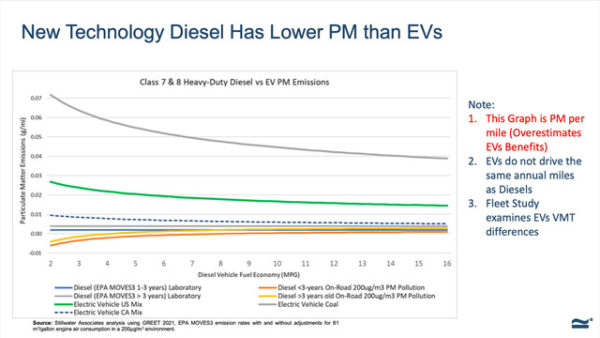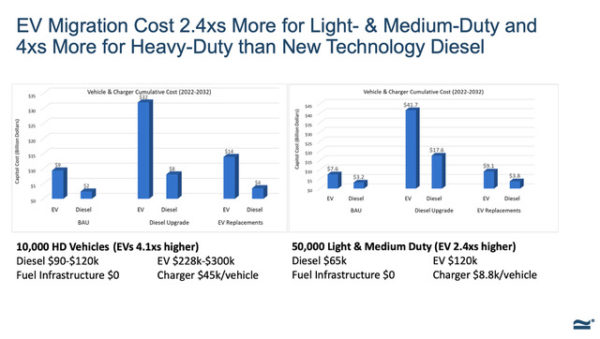Ken Green returns with his patented snark on electric vehicle hype versus the evil gasoline cars most of us drive:
For as long as I’ve been following EHS (Environment, Health, and Safety—the ESG of the last generation) and transportation policy (and that’s a long time, since my first days as a doctoral student/EHS policy analyst at Huge Aircrash Company in the early 1990s), there has been one kind of ICE which has been stubbornly resistant to all of the air pollution control, and later, GHG control policies enacted by the Watermelon left: that ICE is the Internal Combustion Engine.
In those halcyon days, when I could stroll around the corporate office looking at giant oil paintings of Howard Hughes (the Musk before Musk), admire the cockroach-looking look GM Sunraycer parked in the lobby, chat with the guys in the next pod managing the GM EV1 electric vehicle project, and fantasize about shooting a “girls of Hughes” bikini model calendar using the Falcon, AAMRAM, TOE, and Sidewinder missiles that decorated the ground floor of the shopping-mall style corporate office building as props, I would analyze air pollution control policies involving Low-Emission Vehicles (LEVs), and Zero-Emission Vehicles (ZEVs), and invariably, the analyses projecting the future prospects of LEVs, ZEVs, and ICE vehicles had one common feature: ICE vehicles, even in 1990, were routinely projected to be as highly advanced as they were ever going to get.
When compared with the new LEV/ZEV technologies the air pollution panjandrums were pushing, ICE vehicles simply were not seen as competitive: whether it was vehicle fuel economy, emissions absolute, emissions toxicity, emissions per mile driven, or emissions per whatever were always held static as one projected into the future. Meanwhile, the projections for improvements in LEV, ZEV, and battery vehicles were usually shown as geometric, or exponential, as the technology was in its earliest days, and therefore, making the fastest progress it would ever make.
I spotted this trend in all sorts of public policy projections, from vehicle electrification, to projected vehicle/transit mode use…and I took to calling it “The Fallacy of the Static Other” (now that you’ve seen that phrase, you’ll see the fallacy everywhere you look in EHS policy; you can blame Steve for this). You can make any new fancy techno-development look great, if you hold your comparison technology static.
Of course, the fallacy of static-ICE was always…horse…feathers. ICE technology has proven itself to be insanely adaptable, and upgradeable since it was first invented, and it continues to be.
Case in point number five bazillion:
New diesels can cut emissions faster than electric trucks, study says.
Converting to modern diesel engines is a quicker and less costly way to lower harmful emissions than adopting of electric vehicles, especially if now-available near-zero-emissions diesels run on renewable biofuels, says a study commissioned by a diesel advocacy group. Adoption of electric vehicles, few of which are currently available, would cost a trucking fleet three times more than converting to today’s new-technology diesels, the study by Stillwater Associates adds.
The study for the Diesel Technology Forum looked at air-quality conditions in 10 Northeastern states that have adopted California’s regulations for low-emission and zero-emission vehicles, then drew its conclusions.
Specifically, while acknowledging that electric trucks could, of course, lower emissions, researcher Gary Yarnell spracht:
Low-carbon, renewable bio-based diesel fuels cut emissions even more, he said. These fuels can be used in all diesel vehicles today, so fueling those in the study area with 100% renewable diesel resulted in three times larger cumulative greenhouse-gas reductions by 2032 than the EV scenarios, analysis indicates. The results were about the same if B20 – a 20% blend of biodiesel with 80% petroleum diesel – were used.
Electric trucks beat diesels in reducing nitrogen oxide emissions, the study notes. However, electric trucks are generally deployed on shorter routes and run shorter distances than comparable diesel vehicles, so NOx emission reductions with advanced-technology diesels would be greater on a cumulative basis.
Even the artifactual lower present cost of electricity won’t bail out the battery trucks:
The cost of electricity that would run electric trucks is lower now than for diesel, but that’s partly because there’s no road tax on electricity, Yarnell said. If and when authorities add road taxes, the business case for electric trucks would suffer.
So there you have it. ICE survives another climatista assault on its dignity, and place as the most superior transportation technology ever (IMHO) developed!
For those suffering picture withdrawal in Steve’s “absence,” a small fix. (PS, Steve, how can we miss you when you will not go away?) Charts from Diesel Forum Presentation, here.




Notice: All comments are subject to moderation. Our comments are intended to be a forum for civil discourse bearing on the subject under discussion. Commenters who stray beyond the bounds of civility or employ what we deem gratuitous vulgarity in a comment — including, but not limited to, “s***,” “f***,” “a*******,” or one of their many variants — will be banned without further notice in the sole discretion of the site moderator.